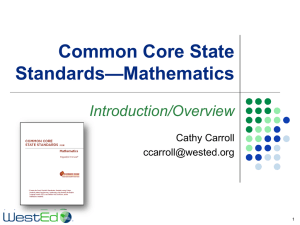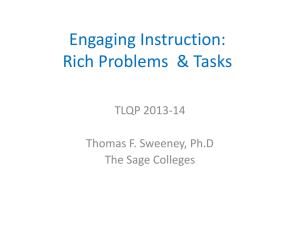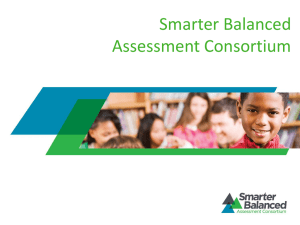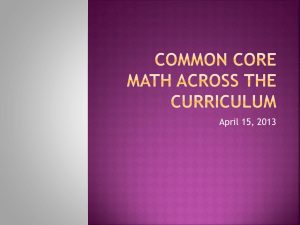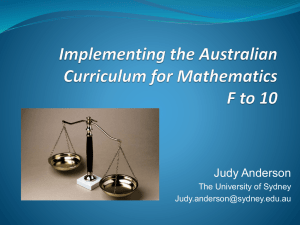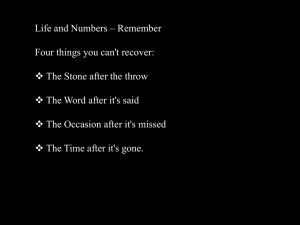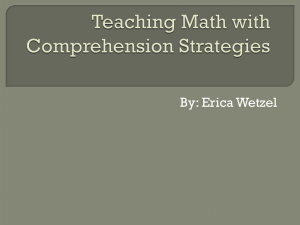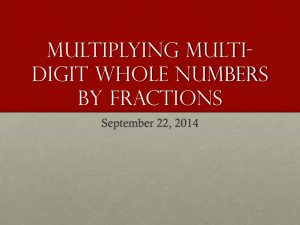Thinking, reasoning and working mathematically
advertisement
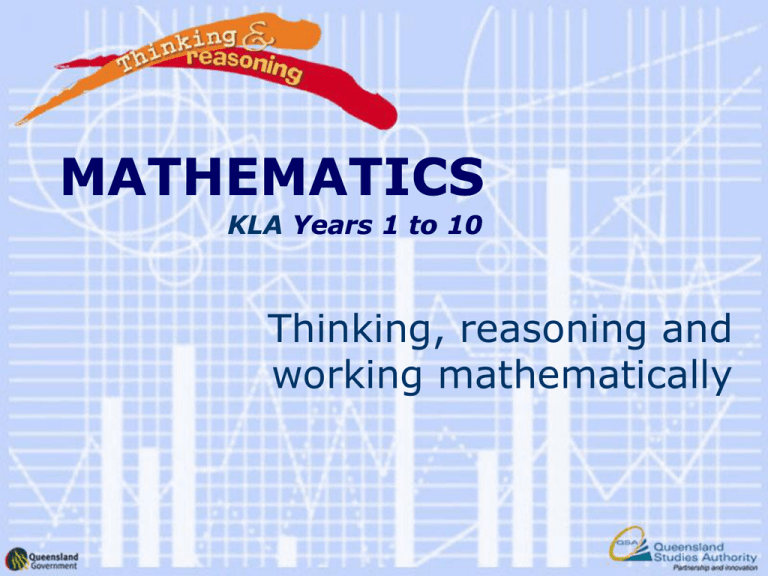
MATHEMATICS KLA Years 1 to 10 Thinking, reasoning and working mathematically Purpose of presentation to define thinking, reasoning and working mathematically (t, r, w m) to describe how t, r, w m enhances mathematical learning to promote and support t, r, w m through investigations. Thinking, reasoning and working mathematically involves making decisions about what mathematical knowledge, procedures and strategies are to be used in particular situations incorporates communication skills and ways of thinking that are mathematical in nature is promoted through engagement in challenging mathematical investigations. Thinking, reasoning and working mathematically also promotes higher-order thinking develops deep knowledge and understanding develops students’ confidence in their ability ‘to do’ mathematics connects learning to the students’ real world. What is thinking mathematically? making meaningful connections with prior mathematical experiences and knowledge including strategies and procedures creating logical pathways to solutions identifying what mathematics needs to be known and what needs to be done to proceed with an investigation explaining mathematical ideas and workings. What is reasoning mathematically? deciding on the mathematical knowledge, procedures and strategies to use in a situation developing logical pathways to solutions reflecting on decisions and making appropriate changes to thinking making sense of the mathematics encountered engaging in mathematical conversations. What is working mathematically? sharing mathematical ideas challenging and defending mathematical thinking and reasoning solving problems using technologies appropriately to support mathematical working representing mathematical problems and solutions in different ways. How can t, r, w m be promoted? By providing learning opportunities that are: relevant to the needs, interests and abilities of the students strongly connected to real-world situations based on an investigative approach — a problem to be solved, a question to be answered, a significant task to be completed or an issue to be explored. Planning for investigations Select learning outcomes on which to focus Identify how and when reporting of student progress will occur Identify how and when judgments will be made about students’ demonstrations of learning Select strategies to promote consistency of teacher judgments Make explicit what students need to know and do to demonstrate their learning Identify how evidence of demonstrations of learning will be gathered and recorded Identify or design assessment opportunities Choose the context(s) for learning Select and sequence learning activities and teaching strategies How do investigations promote t, r, w m? Sample investigations present the learning sequence in three phases: identifying and describing understanding and applying communicating and justifying. Each phase promotes the development of thinking, reasoning and working mathematically. Phase 1 Identifying and describing Students: identify the mathematics in the investigation describe the investigation in their own words describe the mathematics that may assist them in finding solutions identify and negotiate possible pathways through the investigation identify what they need to learn to progress. Sample questions to encourage t, r, w m in phase 1 What mathematics can you see in this situation? Have you encountered a similar problem before? What mathematics do you already know that will help you? What procedures or strategies could you use to find a solution? What do you need to know more about to do this investigation? Phase 2 Understanding and applying Students: acquire new understandings and knowledge select strategies and procedures to apply to the investigation represent problems using objects, pictures, symbols or mathematical models apply mathematical knowledge to proceed through the investigation generate possible solutions validate findings by observation, trial or experimentation. Sample questions to encourage t, r, w m in phase 2 What types of experiments could you do to test your ideas? Can you see a pattern in the mathematics? How can you use the pattern to help you? What other procedures and strategies could you use? What else do you need to know to resolve the investigation? Is your solution close to your prediction? If not, why is it different? Phase 3 Communicating and justifying Students: communicate their solutions or conclusions reflect on, and generalise about, their learning justify or debate conclusions referring to procedures and strategies used listen to the perceptions of others and challenge or support those ideas pose similar investigations or problems. Sample questions to encourage t, r, w m in phase 3 What is the same and what is different about other students’ ideas? Will the knowledge, procedures and strategies that you used work in similar situations? What mathematics do you know now that you didn’t know before? Teachers can support t, r, w m by: guiding mathematical discussions providing opportunities for students to develop the knowledge, procedures and strategies required for mathematical investigations presenting challenges that require students to pose problems providing opportunities to reflect on new learning. The syllabus promotes t, r, w m by: describing the valued attributes of a lifelong learner in terms of thinking, reasoning and working mathematically encouraging students to work through problems to be solved, questions to be answered, significant tasks to be completed or issues to be explored advocating the use of a learner-centred, investigative approach in a range of contexts emphasising the connections between topics and strands that are often required in dealing with mathematics in ‘real-life’ situations. Materials to support thinking, reasoning and working mathematically How to think, reason and work mathematically (poster) About thinking, reasoning and working mathematically (information paper) Prompting students to think, reason and work mathematically (paper) Thinking, reasoning and working mathematically in the classroom (paper) Papers described in the annotated bibliography in the ‘Additional information’ section of the support materials Contact us Queensland Studies Authority PO Box 307 Spring Hill Queensland 4004 Australia Phone: +61 7 3864 0299 Fax: + 61 7 3221 2553 Visit the QSA website at www.qsa.qld.edu.au


